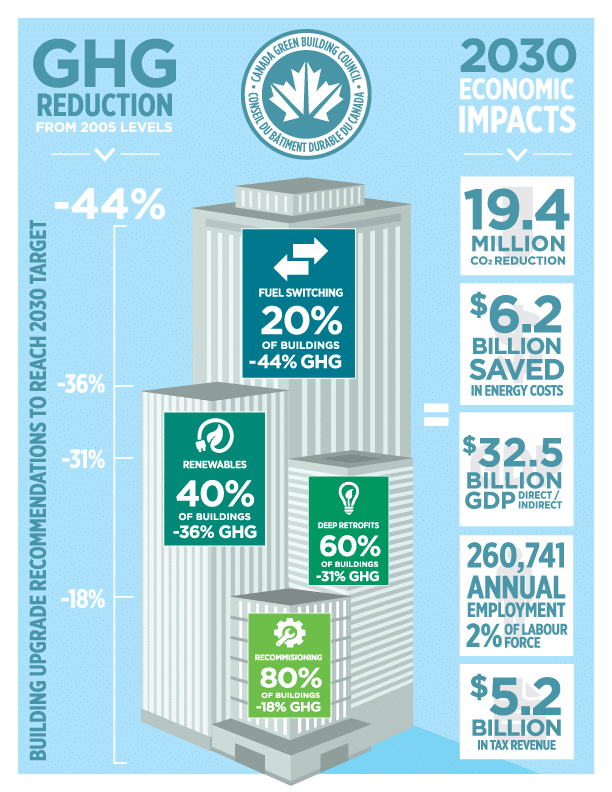Building Solutions to Climate Change
How green buildings can help meet Canada’s 2030 emissions targets
The CAGBC was invited to provide recommendations in response to the Vancouver Declaration on Clean Growth and Climate Change, which committed Canada to meeting or exceeding the federal government’s 2030 target of a 30 per cent reduction below 2005 levels of greenhouse gas (GHG) emissions.
The report outlines four key recommendations aimed at meeting Canada’s climate change targets while fueling the growth of Canada’s sustainable building industry. The recommendations are substantiated by research from WSP Group and Acton White Associates, commissioned to examine the carbon savings potential of existing buildings and net zero buildings, and also to analyze the required investment and economic benefits.
The four recommendations include new data proving the effectiveness of these measures, if taken immediately:
- Meet Canada’s climate change targets by investing in and providing incentives for energy efficiency improvements (such as recommissioning, deep retrofits, solar and renewable onsite energy systems, and switching of fuel systems) in existing buildings commercial, institutional and high-rise residential buildings over 25,000 sq.ft, to reach high-performance energy efficiency. The report finds that if such measures are taken by 2030, Canada will reduce GHG emissions by 19.4 million CO2e tonnes (or 44 per cent) from the 2005 baseline, with energy-related cost savings of $6.2 billion and direct and indirect GDP impacts of $32.5 billion.
- Strengthen building performance by advancing building energy benchmarking, reporting and disclosure initiatives – including expanding the ENERGY STAR Portfolio Manager Program. To date, over 13,000 buildings have used Portfolio Manager, but investment is needed to expand this service and support a wider range of buildings types.
- Invest in net zero buildings by supporting a National Net Zero Building Initiative to create a Canadian standard to guide the industry. The report finds that if all new buildings above 25,000 sq. ft. were built to be net zero carbon between now and 2030, GHG emissions for this sector would be 17 percent lower than those in 2005, equal to a 7.5 megatonnes GHG emissions reduction.
- Reduce the Government’s GHG Emissions by adopting advanced high-performance green building measures for federal building renovations, new construction and leased properties, and, where appropriate, net zero demonstration projects for new construction. Implementing carbon reduction activities for federally-owned buildings over 25,000 sq.ft, which account for three to five per cent of building sector emissions, will result in GHG emissions reductions of approximately 480,000 tonnes and cost savings of approximately $170 million annually.
The following infographic details some key findings from the Building Solutions to Climate Change report:

